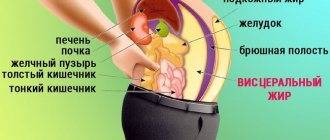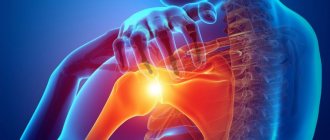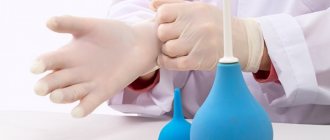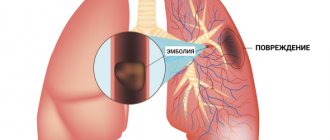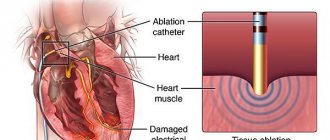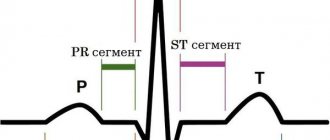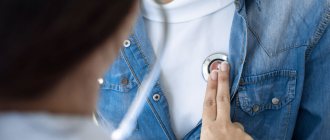Injuries, wounds, and poisoning can trigger the stoppage of the body’s main “motor”—the human heart. Stopping blood circulation entails the cessation of tissue and gas exchanges. Without blood flow, waste products accumulate inside the cells, and carbon dioxide accumulates in the blood. Metabolism stops, cells begin to die due to lack of oxygen and intoxication with metabolic products.
In this case, it is very important to at least try to carry out resuscitation measures - cardiac massage. There is a limited time allotted for this procedure - only thirty minutes. After this period, clinical death becomes irreversible.
Symptoms of cardiac arrest
Signs indicating cardiac arrest are: stopping the pulse (inability to feel the pulse in the carotid artery); respiratory arrest (the patient’s chest is motionless, a mirror brought to the mouth and nose does not fog); dilated pupils that do not respond to light; loss of consciousness, and the person does not come to his senses when hearing loud sounds or patting on the face; bluish-gray skin tone.
If there are fresh wounds on the body, then when the heart stops bleeding from them stops.
Content:
- Symptoms of cardiac arrest
- Types of heart massage
- The essence and algorithm of massage
- Rules for performing massage
Efficiency. Professionalism. Mercy
Find out whether the person is conscious or not
If you see that a person in front of you has fallen unconscious or is lying in the middle of the street or in any other place where he should not be lying, then come up and clarify the situation.
To do this, you need to approach from the head and clearly ask: “Do you need help?”
If no response is received, check tactile and pain sensitivity: place your palms on the victim’s cheeks and, fixing the head with one hand, pat the cheek with the other with the force of a slap, the head should not move.
If there is no reaction, you must:
- release your neck and carefully check the pulse in the carotid artery (in the neck) with three fingers;
- check breathing by movement of the chest and abdominal wall.
All this must be done within 10 seconds at the same time.
Indirect massage: saving a person
So, you have discovered the absence of any reaction, the absence of a pulse and breathing, which means it’s time to save the person. If there are still passers-by nearby, ask them to call an ambulance and begin resuscitation yourself.
- Position yourself at the victim's side, with your knees lightly touching their arm.
- Place your right or left hand on the lower half of the sternum (if the sternum is divided into two parts), place the other hand on top. All joints should be motionless, arms straight.
- Then do smooth compressions without interruption with a compression depth of 5-6 centimeters, frequency – two compressions per second up to 30 times. After this, check your pulse. If there is a pulse, but breathing does not appear, then artificial respiration is necessary.
- There is one nuance here: it is necessary to perform artificial respiration on a stranger through gauze or a handkerchief, but neither one nor the other may be at hand. In addition, many are frightened by this particular “point” in first aid – mouth-to-mouth breathing. Therefore, today there is a technique to avoid these actions.
- From any object (scarf, shoes, jacket or bag), make a cushion as thick as the victim’s arm and place it under the neck, shoulders, that is, under the upper back. The head will be fixed in a tilted position, the airways will be cleared for the movement of air into the lungs, which will flow during chest compressions. That is, we perform indirect cardiac massage on the victim with his head thrown back and control the pulse. If it does not recover, we continue to perform indirect cardiac massage.
Sometimes people are afraid that they might break their ribs with such actions, but if the base of the palm is located lengthwise on the lower half of the sternum, then you will not allow this to happen. In people under 75 years of age, the connective tissue between the ribs and sternum is elastic. Severing a rib from the sternum is possible if the victim is over 75 years old, but even in this case, pushing through the sternum must be carried out by 5-6 cm, otherwise the massage will be ineffective.
IMPORTANT! With children, all resuscitation actions are exactly the same, only the effort should be less. From 0 to 1 year of life, the chest is grabbed with both hands, two fingers are placed on the lower part of the sternum and compressions are performed - indirect cardiac massage. The chest should be compressed to one third of its diameter. When performing mouth-to-mouth artificial respiration, the inhalation should not be as intense as that of an adult.
If you become a bystander from whom assistance is required, you have the knowledge of how to help, then it will be your civic duty to do so.
The editors of the Internet Portal NEDUGAMNET.RU thanks the State Budgetary Healthcare Institution of the Tyumen Region “Emergency Medical Care Station” for their assistance in preparing the article.
photo: https://nedugamnet.ru/articles/2832
Types of heart massage
Today, there are two methods of cardiac massage: direct (open) and indirect (closed).
Direct massage is carried out exclusively by qualified medical professionals and only in certain conditions: in particular, during surgery on the thoracic or abdominal organs. The essence of the procedure is to directly compress the heart muscle with your hands through an incision in the chest or abdomen (in this case, the massage is carried out through the diaphragm). Due to the complexity of performing direct massage of the heart muscle, it cannot be performed by people without appropriate medical education and training.
Indirect (closed) massage of the heart muscle can be performed in any conditions. This is the simplest way to help restore cardiac activity. No medical devices are required to perform it.
Indirect cardiac massage provides that during pressure on the chest, the chambers of the heart will also be compressed. As a result, blood will enter the ventricles from the atria through the valves, and then go into the vessels. Thanks to rhythmic pressure on the chest, the movement of blood through the vessels will not stop. As a result, the organ’s own electrical activity and independent functioning are activated.
Of course, a cardiac massage can only be successful if the algorithm of action is carefully followed and the rescuer follows the approved technique for carrying out resuscitation measures. Massage must be combined with artificial ventilation. Each pressure on the victim’s chest provokes the release of about five hundred milliliters of air. When the compression stops, the same portion of air is sucked into the lungs. As a result, passive inhalation and exhalation occur.
The essence and meaning of cardiac massage
The purpose of cardiac massage is to artificially recreate and replace cardiac activity if it stops. This can be achieved by squeezing the cavities of the heart from the outside, which imitates the first phase of cardiac activity - contraction (systole) with further weakening of pressure on the myocardium, which imitates the second phase - relaxation (diastole).
This massage can be done in two ways: direct and indirect. The first is possible only with surgery, when there is direct access to the heart. The surgeon takes it in his hand and performs a rhythmic alternation of compression and relaxation.
Indirect cardiac massage is called indirect because there is no direct contact with the organ. Compression is applied through the chest wall, as the heart is located between the spine and the sternum. Effective pressure on this area can release about 60% of the blood volume into the vessels compared to self-contracting myocardium. Thus, blood will be able to circulate through the largest arteries and vital organs (brain, heart, lungs).
The essence and algorithm of massage
External cardiac massage is a rhythmic compression of the heart by compression between the sternum and the spine. Experts note that the chest of a person with cardiac arrest becomes more pliable due to loss of muscle tone, making it easy to perform compressions. The person providing assistance, if the NMS technique is followed, can easily displace the chest by three to five centimeters. Compression of the heart leads to a decrease in its volume and an increase in intracardiac pressure.
Rhythmic pressure on the chest area results in a difference in pressure inside the heart cavities, the blood vessels that extend from the heart muscle. Blood from the left ventricle travels through the aorta to the brain, while from the right ventricle it flows to the lungs, where it is oxygenated.
After the pressure on the chest stops, the heart muscle straightens, intracardiac pressure decreases, and the chambers fill with blood. As a result, artificial circulation is recreated.
You can perform a closed massage of the heart muscle only on a hard surface. The person must be placed on the floor. After this, it is necessary to perform the so-called precordial punch. It should be directed to the middle third of the chest. The impact height should be thirty centimeters. However, according to recent data, the value of the precordial stroke is significantly reduced, and many experts do not recommend starting resuscitation measures with it. In order to conduct a closed cardiac massage, the person providing assistance places the palm of one hand on the other, after which he begins to carry out uniform pushes according to the established technique.
Cardiac massage during cardiopulmonary resuscitation
quality control devices for chest compressions during cardiopulmonary resuscitation
Kobylkin
I.S., 2013.
The number of people who die annually in Russia from sudden cardiac arrest (SCA) (or sudden cardiac death - SCD) is comparable to the population of a large city and amounts to about 300,000 cases. According to official statistics, in Europe and America, in 1-5 cases for every thousand hospitalized patients, there is a need for cardiopulmonary resuscitation (CPR). According to statistics from the World Health Organization, 30 people per million people die suddenly per week. In the United States, timely and properly performed CPR can save 100,000 to 200,000 lives annually.
Sudden cardiac death accounts for 15-20% of all non-violent deaths among residents of developed countries and can overtake even an absolutely healthy person without preliminary signs of diseases of the cardiovascular system, suddenly and without regard to age. There is still no comprehensive answer to the question of the causes of this phenomenon. About 75% of cases of SCA occur at home, at work, in places of recreation, and only 25% of cases occur in medical institutions. Without first aid, about 91% of victims of SCA die before reaching the hospital.
Many of these people could live if those around them had basic first aid skills, and if there were technical means nearby to help them correctly and effectively perform resuscitation. The life of the victim depends only on the actions of eyewitnesses at the scene of the incident! Bystanders who know CPR techniques and begin resuscitation measures on time become an extremely important life-saving link in the emergency medical care system.
CPR is an emergency medical procedure aimed at restoring the body’s vital functions and bringing it out of a state of clinical death. CPR includes chest compressions (CCM) and artificial lung ventilation (ALV). It is necessary to begin CPR of the victim as early as possible - the result directly depends on the time of the start of resuscitation and the adequacy of the actions. With every minute of inactivity, the chance of surviving SCA decreases by 7–10%. The absence of spontaneous or artificial circulation for more than 5 minutes means the onset of irreversible brain damage and, as a result, biological death.
The main parameters of CPR are the frequency, depth of compressions, and their quantitative relationship with ventilator breaths. To perform compressions on victims to the value recommended by international standards of more than 5 cm, a pressing force of an average of 10 to 55 kg is required, which is not easy to assess in a stressful situation. The rigidity of the chest is different for a man and a woman, plump and thin, young and elderly, and therefore different efforts must be applied. It is important to remember that a compression depth of less than 5 cm, as well as a decrease in the frequency of compressions, less than 100 per minute, will lead to a significant decrease in cardiac blood flow, which in turn sharply reduces the effectiveness of resuscitation. On the other hand, compressions deeper than 6-7 cm can lead to injury to internal organs and fractured ribs. Rates greater than 120 per minute are not as effective as they cause increased rescuer fatigue and may lead to early exhaustion of the rescuer and a reduction in the overall duration and quality of CPR. In addition to all this, you need to adhere to a certain sequence of resuscitation actions, constantly count the number of compressions performed and maintain a ratio of 30 compressions / 2 artificial breaths into the victim’s lungs.
For most first aid providers, incorrect CPR is due to insufficient CPR practice and lack of objective monitoring of its effectiveness. It is impossible to master CPR only by reading a book; it is necessary to learn practical skills and bring them to automatism. Ideally, everyone should take such a course under the guidance of experienced instructors who would not only show how to do it, but also directly supervise hands-on training on mannequins simulating a victim of sudden cardiac death.
Knowing the techniques and having the skills to perform CPR does not mean being able to use them in a stressful, unfamiliar environment, without room for error. Performing CPR is hard and stressful work. The situation around, the consciousness of the victim, the presence of blood circulation - the rescuer is immersed in a mass of thoughts and his attention is immediately scattered on many factors, which he, nevertheless, must evaluate and control. What to do first and what second? After all, you only have 5 minutes to take action and save a life.
How to evaluate the correctness of your actions?
Practice shows that the CPR skill is quickly lost - even medical workers trained in specialized courses, during a test test, in 20% of cases perform CPR with insufficient effectiveness during the first minutes of resuscitation, and with prolonged resuscitation, the quality of NMS performance decreases in the majority of all examinees. Over time, in the absence of practice, skills are lost more and more. The feeling of self-confidence is lost. There is a fear of doing something wrong and making the situation worse.
The question arises about the advisability of using certain auxiliary devices that would assist in carrying out CPR by providing feedback on the “adequacy” of actions and interactive interaction with the rescuer in real time, with the help of which one could easily learn, maintain and improve one’s skills in mannequins
Devices for similar purposes exist. They appeared on the market relatively recently, and immediately found wide application in the practice of emergency services in a number of countries. The most well-known devices that implement the feedback principle to assist in CPR:
| Manufacturer | FactorMedTechnics | BIO-DETEK Inc | Health Affairs Ltd | Laerdal Medical |
| A country | Russia | USA | Australia | Norway |
| Website | factor-mt.ru | pocketcpr.com | cprezy.com | laerdal.com |
| Reg. Number | FSR 2012/13796 | FSZ 2011/09925 | FS No. 2006/1225 | No |
| price, rub. * | about 6000 | about 7000 | about 12000 | about 32000 |
| Basis of measurements | 3D – acceleration sensor | 2D – acceleration sensor | Spring with a group of contacts | Force and acceleration sensor |
| Controlled parameter | Actual movement of the sternum | Actual movement of the sternum | Pressure force on the sternum | Movement and pressure on the sternum |
| Display of NMS effectiveness | Scale of 9 indicators of different colors | Scale of 4 red indicators | Scale of 5 indicators of different colors | Slider on color display 28 x 28 mm |
| Display Features | Deflection depth indication is proportional to actual movement | The compression depth scale has only 2 states: small and sufficient | The compression depth scale is calibrated according to the patient’s weight | Graphic representation of the deflection scale with a running line |
| Additional display | 2 indicators of the order of actions during CPR and metronome rhythm | No | Metronome beat indicator | Time from the beginning of the pause on mechanical ventilation, pressing force, NMS statistics |
| Voice prompts | Yes - Russian language | Yes - Russian language | No | No |
| Compression frequency beep | Yes (last 5 out of every 30 in a higher tone) | Eat | Eat | No |
| Counter of 30 compressions, pause for ventilation | Yes, there is a voice prompt | Yes, there is a voice prompt | No | Yes, shown on the display |
| Counting two-minute NMJ cycles | Yes, there is a warning | No | No | No |
| Working position | Worn on the hand | Placed between chest and arms | Placed between chest and arms | Placed between chest and arms |
| Wireless connection to PC | Possible | No | No | No |
| Operating time, h | 6 — 9 | 8-10 | 7-9 | 3 — 4 |
| Auto shutdown | Eat | No | Eat | Eat |
| Equipment | Device with battery, case, ventilator cloth, gloves, instructions and training disc in Russian | Device with battery, instructions in Russian | Device, mask, gloves, battery, instructions and training disc in Russian | Device with battery, case, chest stickers, MicroSD card, instructions in English |
| Battery, Shelf life | Lithium, 3V 10 - 15 years | Lithium, 3V 10 - 15 years | Alkaline, 9V 5 – 7 years | Lithium, 3V 10 - 15 years |
| Weight, gram | 110 | 82 | 260 | 227 |
| Dimensions, mm | 90x70x25 | 105 x 51 x 25 | 180 x 55 x 50 | 154 x 64 x 28 |
* — the table shows the approximate cost of devices and may differ from actual values.
CPRmeter
located between the sternum and the resuscitator's arm. During the NMS process, the display of the device displays a compression depth scale, a dial indicator of the frequency of compressions and a digital counter of 30 compressions. An additional force sensor detects the absence of pressure between compressions to let the rescuer know how to release their arms to allow the chest to fully expand. When performing NMS, the slider in the form of a white stripe moves up and down in proportion to the depth of compression. The intersection of the upper oval corresponds to the absence of pressure on the sternum, the lower – the recommended depth of deflection. If the line goes beyond the lower oval, the recommended compression value has been exceeded. If there is insufficient compression or there is pressure between compressions, a yellow arrow appears in the corresponding direction, which warns of the need to adjust the compression force in one direction or another. The compression frequency indicator deviates to the left when the compression rate decreases from the norm and to the right when it is exceeded. The manufacturer recommends using special stickers to adhere the CPRmeter to the victim's chest. If there is hair, it is suggested to shave it off.
The advantage of the CPRmeter is the function of storing information about the progress of many CPR cases on a memory card, which can then be visualized on the device itself or on a computer and objectively assess the correctness of assistance to the victim.
The CPRmeter does not produce any sound signals, which requires the rescuer to constantly pay attention to the small display of the device, which is in motion during operation.
The principle of operation of CPREzy is significantly different from all other devices under consideration and consists in the fact that it is not the actual depth of compression that is measured, but the force of pressure on the chest, which is translated into the expected movement depending on the patient’s weight. There are no sensors here, only a spring and an electronic converter of its compression value into indications of the effectiveness of the NMS. The device scale consists of five indicators for different weights of patients - 40, 55, 75, 90 and more than 100 kg. During CPR, it is necessary to visually assess the weight of the victim and achieve a compression force that correlates with the readings of the corresponding weight indicator. The advantage of CPREzy is that it comes with a mask for mechanical ventilation with a non-reversible valve and a nose-clamping mechanism, and a case in the form of a first aid kit for mounting the kit on the wall. Possibility of use in conditions of movement and shaking of the patient, for example, inside a vehicle, since any device based on an accelerometer requires the patient to be positioned on a rigid, stationary or uniformly moving surface.
The disadvantages of CPREzy include the relative approximation of the measurement method (since it is impossible to standardize the chest rigidity of patients of the same weight), the lack of voice prompts (only a metronome signal is present). The use of a lithium battery with a short shelf life (the manufacturer recommends changing the battery at least once a year), the absence of a compression counter and a fairly large size.
Training NMS skills using CPREzy requires a manikin with a certain sternum resistance adequate to a given patient weight, since the amount of movement of the sternum strictly depends on the strength of its resistance to compression. The use of a softer simulator instead of a special manikin, for example, will lead to greater movement of the sternum with the same indication of the effectiveness of NMS on the device. As a result, during training, a rescuer may remember incorrect sensations from the compressions he performs. Devices based on an accelerometer do not have this drawback, because measure actual movement.
PocketCPR
also located between the sternum and the resuscitator's arm. It has an NMS effectiveness scale consisting of 4 indicators. There is no proportional dependence of the number of included indicators on the depth of the chest deflection; everything is limited to only two states of its functioning. The scale displays information as follows. The rightmost LED blinks during the entire time the device is turned on at the frequency of the specified compression tempo. When performing cyclic movements, a metronome sound signal is activated simultaneously with the flash. This indication state, combined with periodic voice prompts to “press harder,” is typical for insufficient compression depth. The second state is when all LEDs blink at the same frequency, which indicates that the minimum compression threshold has been overcome and is considered good compression. A periodic voice message “good compression” sounds. The efficiency indicator flashes not with the frequency of the compressions actually performed, indicating the effectiveness of each of them, but with a constant metronome frequency of 100 per minute. In fact, if the rescuer performs NMS with a frequency of less than 80 compressions per minute, the stability of the indication is disrupted, because resynchronization of these two frequencies occurs. PocketCPR does not have an indication that the chest compression depth has been exceeded. Moving the sternum 5 or 10 cm will look the same. The device continues to report good compression even when moving up to 12 cm, which is a negative point, as it can lead to damage to the ribs or internal organs of the patient. Movements of more than 12 cm are filtered out by the device and are not processed in any way. PocketCPR operates in two modes. The "normal operation" mode is activated by briefly pressing the power button and includes voice prompts and a metronome sound. The 25 second opening speech is not to be missed. It must be listened to in its entirety for the metronome to sound and the NMS effectiveness indicator to work. In the “silent” mode, which is activated when turned on by holding the power button for about 2 seconds, there is no introductory speech. The device is immediately ready for use. In this mode, the metronome flashes and silently displays the effectiveness of the NMS. In this mode, the rescuer must independently count the compressions he performs, since the device will not pause the ventilator, and report such a need. Modern CPR rules say that if a rescuer cannot perform mechanical ventilation on a victim, he must perform NMS without stopping. Let's consider a similar situation when operating in “normal operation” mode. After 30 metronome signals, regardless of the presence of real compressions, the device issues a voice command to take two breaths. But at the same time, the metronome sound turns off, the indication of the effectiveness of the NMS stops, and PocketCPR goes into a 7-second pause, waiting for the end of the mechanical ventilation phase in time. If at this moment the rescuer continues to massage, he will automatically lose the help of the device. This circumstance is also an unpleasant moment, as it can lead to deviations in the parameters of the NMS and a decrease in its effectiveness. As was said earlier, in the “silent” mode the device does not pause during ventilation and the rescuer can perform NMS continuously for as long as desired. The downside is that to constantly monitor efficiency, the savior must constantly look at the indicator. PocketCPR does not have an automatic power-off feature. When the device is turned on and left alone without movement, it automatically stops the metronome sound, waiting for signs of the onset of NMS. At the same time, he runs the risk of remaining unnoticed and losing all battery power.
PR-01
(Reanimator Assistant) - developed by a Russian company. One of the differences from the devices under consideration is the location during operation. PR-01 is put on the hand - left or right and is securely held with an elastic belt. The device is placed on top of the hands folded into a “lock” on the patient’s sternum. Located on the back of the “upper” hand, the device is constantly in the rescuer’s field of vision, while blocking the indication and sound channels with one’s own hands or sleeves of clothing becomes impossible. There is no need to waste time undressing the victim and gluing the device to the chest. Being on the rescuer's hand, unlike other devices, PR-01 does not injure the sternum, does not interfere with other manual manipulations and does not slip out of wet hands. PR-01 has an intuitive 9-segment indicator, which gives a clear idea of the effectiveness of the ongoing NMS. For ease of reading, the scale is divided into 3 areas, highlighted in different colors - yellow, green and red, which correspond to the zones of insufficient, optimal and excessive chest compression. The number of indicators that light up during compressions is directly proportional to the depth of compression of the chest and quite clearly provides visual feedback on the amount of deflection. The effectiveness scale indicators flash at the rate of actual compressions performed. During NMS, after three consecutive insufficient compressions, a voice warning sounds - “stronger”. After the first excessive compression, a voice warning sounds - “less force.” When the power is turned on, the device performs self-diagnosis, after which it informs the rescuer by voice about the procedure for further action. A voice message sounds: “Perform a closed cardiac massage in the rhythm of the machine. Listen for clues. If you don’t know artificial respiration methods, perform continuous massage.” Pressing the ON button again allows you to skip the prompt and immediately begin NMS. The light indicator “do 30 compressions” lights up synchronously with the acoustic signal that sets the CPR rhythm - 100 times per minute. When automatically counting 30 effective compressions (those greater than 5 cm), the metronome signal turns off, the “take 2 breaths” indicator lights up and the voice command “take two breaths” follows. Next, the rescuer is given time to perform mechanical ventilation. If NMS is continued without a break in mechanical ventilation, the metronome turns on and continues working automatically when movement characteristic of NMS is detected. The indication of the effectiveness of the NMS is not interrupted at any point in time. When performing five massage cycles (30 compressions and 2 breaths), a voice message follows: “the first two-minute cycle has been completed,” “the second two-minute cycle has been completed,” etc. This allows you to navigate the time of CPR, and indicates to medical workers the time for additional activities – monitoring the patient’s condition, defibrillation, intubation, administration of medications, changing the rescuer performing NMS. You don’t have to worry about battery drain if you accidentally turn on the power or leave the device on. The intelligent auto shutdown function will de-energize it after 10 minutes of inactivity without movements characteristic of the NMC. For training centers, there is a modification PR-01 equipped with the function of wireless data transmission to a personal computer via Bluetooth, which, when combined with a specialized software package, allows you to remotely monitor the work of a trainee or take qualifying exams for several people at once.
Conclusion
About 40 percent of those who are already resuscitated suffer another cardiac arrest within the next two years. The environmental situation and the steady growth of various diseases do not leave prerequisites for reducing the number of cases of sudden cardiac arrest. It is obvious that the introduction and use of the CPR quality control devices discussed in the review in the practice of CPR training and real-life application will significantly increase the chances of survival of victims and reduce the level of injuries and mortality.
The target consumer audience of the reviewed devices may include both professional rescuers and ambulance doctors, whose goal is maximum efficiency and safety of their actions during CPR, as well as any people who already have a basic understanding of the principles of CPR or want to master them - schoolchildren studying in classes Life safety, university students of various fields, such as medicine or the Ministry of Emergency Situations, traffic police inspectors, firefighters, etc.
The devices can be recommended for equipping resuscitation kits, for completing industrial, office and other first aid kits in crowded public places.
Currently, in accordance with Order No. 388n dated June 20, 2013 of the Ministry of Health of the Russian Federation “On approval of the Procedure for providing emergency, including specialized emergency medical care” when equipping class “A” ambulances (clauses 2.1 and 3.1) , inpatient emergency departments of a hospital (clause 1.131), short-stay emergency departments (clause 2.14.42), as well as in accordance with Order No. 549n dated August 7, 2013 of the Ministry of Health of the Russian Federation “On approval of equipment requirements medicines and medical products, packages and kits for emergency medical care” to equip an emergency medical resuscitation kit (p. 40, p. 27), the use of a quality control device for conducting NMS with voice prompts is provided.
Only two of the devices discussed in the review fall into this category: PR-01 and PocketCPR.
Taking into account the features of all the devices presented above, comparing their pros and cons, today the most appropriate choice among the presented devices to assist in carrying out NMS during CPR is the new domestic device PR-01 produced by the FactorMedTekhnika company.
Additional information about PR-01. (Assistant resuscitator, TU 9441-016-70273484-2012).
Full name: Device for indicating the effectiveness of chest compressions and coordinating the sequence of actions when performing cardiopulmonary resuscitation measures.
Functions performed:
- gives voice instructions on how to perform CPR;
- sets the NMS frequency to 100 1/min. using an acoustic signal and a flashing light indicator;
- displays an indication of the actual depth of the chest deflection with light signals of different colors;
- gives voice instructions to increase or decrease pressing force;
- calculates 30 effective compressions for mechanical ventilation;
- counts two-minute NMS cycles;
- carries out automatic monitoring of the battery condition.
Benefits of use:
- gives confidence in the correct performance of CPR;
- increases the effectiveness and consistency of chest compressions during CPR;
- reduces the risk of damage to internal organs or insufficient compression;
- promotes chest compressions with the required strength and frequency;
- being on the rescuer's hand, it does not interfere with other manual manipulations and does not injure the sternum.
Complies with recommendations:
- European Resuscitation Council (ERC) 2010;
- International Liaison Committee on Resuscitation (ILCOR);
- American Heart Association (AHA) CPR and Emergency Cardiovascular Care 2010;
- Educational and methodological manual “Cardiopulmonary and cerebral resuscitation” (V.V. Moroz et al.), approved at a meeting of the Academic Council of the Research Institute of OR of the Russian Academy of Medical Sciences on March 22, 2011.
Thanks to its ease of use and low cost, PR-01 provides the opportunity for everyone to learn and perform CPR with confidence and maximum efficiency. PR-01 is suitable both for training, development or restoration of CPR skills, and for practical use in emergency situations as auxiliary medical equipment that implements the feedback principle.
PR-01, used in conjunction with even the simplest mannequin, is an excellent and inexpensive solution for training centers. The use of individual devices will allow increasing the number of students in a group without reducing the quality of training. There are no domestic devices for this purpose.
This article does not claim to be a complete coverage of all the issues presented and is compiled on the basis of materials obtained from the official websites of manufacturers and distributors of the devices in question, as well as trial operation of samples.
Rules for performing massage
For the emergency measures taken to be effective, it is extremely important to follow the cardiac massage technique. Only in this case, the efforts made to restore the victim’s cardiac activity can be justified.
When performing cardiac massage, the following rules should be observed:
- The rescuer kneels in front of the victim lying on the ground or floor. It doesn't matter which side he is on. However, if the rescuer is right-handed, it will be more convenient for him to perform a precordial blow if he places his right hand towards the victim.
- Place the base of your right palm slightly above the xiphoid process. The thumb should be directed either towards the chin or towards the victim’s abdomen.
- The arms of the person performing chest compressions must be fully straightened. When the chest is displaced, the center of gravity must be moved to the chest of the person being assisted. As a result, the rescuer will be able to preserve his strength. If you bend your arms at the elbow joints, they will quickly get tired.
- For resuscitation to be successful, first aid must arrive within half an hour. The frequency of pressure on the victim’s chest is sixty times per minute.
- The depth to which chest compressions must be performed is three to five centimeters. In this case, the person providing assistance should not take their palms off the victim’s chest.
- The next pressure on the chest should be done only after it returns to its original position.
- During NMS, rib fractures are possible. This is not a reason to stop resuscitation measures. The only clarification is that pressure should be performed a little less often, but their depth should remain the same.
- Simultaneously with NMS, artificial respiration is also performed. The ratio of chest compressions to ventilation should be 30:2. Compression on the victim's chest provokes exhalation, and the return of the chest to its original position is a passive inhalation. As a result, the lungs are saturated with oxygen.
- During resuscitation measures, more attention should be paid to closed cardiac massage rather than artificial respiration.
Algorithm for performing indirect cardiac massage
Closed cardiac massage will be effective only if it is performed in accordance with the algorithm. You must proceed as follows:
- First of all, determine the place where the compression will be carried out. There is a common belief that a person's heart is on the left. This is not entirely true. In fact, you should not press on the left side, but on the center of the chest. This is extremely important, because if you apply compression to the wrong place, you can not only fail to achieve the desired effect, but also cause harm. The point that we need is located in the center of the chest, at a distance of two fingers from the center of the sternum (where the ribs touch).
- Place the heel of your palm at this point so that your thumb “looks” either at the victim’s stomach or chin, depending on which side of him you are on. Place your second palm crosswise on top of the first. Please note that only the base of the palm should be in contact with the body of the person you are helping. Fingers should remain hanging.
- Don't bend your elbows. It is necessary to apply pressure using your own weight, and not the strength of your arm muscles, because otherwise you will quickly get tired, and the force of pressure at each point will be different.
- With each pressure, the victim's chest should drop to a depth of five centimeters. In other words, the compression must be strong, because this is the only way you will be able to properly disperse the blood throughout the body so that it delivers oxygen to the brain.
- Artificial ventilation is performed between compressions. Its cyclicity is two breaths for every fifteen shocks.
Signs that resuscitation was successful are the appearance of a pulse in the area of the carotid artery, as well as the reaction of the person’s pupils to light.
Conducting a closed heart massage for a child
Unfortunately, sometimes there are situations when, for one reason or another, a child’s heart stops. In this case, the reaction of people nearby should be immediate - the baby must immediately begin closed heart massage, since every second of lost time brings a tragic outcome closer.
In infants, clinical death can be caused not only by sudden death syndrome, but also by neurological diseases, sepsis, drowning, airway obstruction, acute bronchospasm, pneumonia, severe trauma or serious burns and other diseases.
Indications for chest compressions for infants and older children are: sudden deterioration in the child’s condition, fainting, absence of heartbeat when palpating the carotid artery, cessation of respiratory activity, lack of pupillary response to light.
Features of the procedure for children
Carrying out resuscitation of children has a number of features.
First of all, chest compressions should begin in babies immediately after signs of clinical death have been detected. At the same time, artificial respiration is carried out, before starting which it is necessary to ensure the free passage of air through the respiratory tract.
Indirect cardiac massage in newborns is performed with little effort. Infants are placed on their backs, with their shoulders facing them. The thumbs should touch the front of the chest, and their base will be on the lower third of the chest.
In addition, a closed massage of the heart muscle of a newborn can be performed by placing it on your forearm, and holding its head slightly tilted back in the palm of your hand.
When performing NMS, children under one year of age should use only two fingers for pressure - the second and third. The frequency of compressions should be from eighty to one hundred per minute.
Best materials of the month
- Coronaviruses: SARS-CoV-2 (COVID-19)
- Antibiotics for the prevention and treatment of COVID-19: how effective are they?
- The most common "office" diseases
- Does vodka kill coronavirus?
- How to stay alive on our roads?
Heart massage for children aged one to seven is done while standing to the side of them, using the heel of the palm.
When resuscitating children over eight years old, massage is done with both hands. The main thing when performing NMS for a child is to carefully calculate the strength. Excessively strong pressure can lead to damage to the chest, which, in turn, can lead to injuries to internal organs and the development of hemo- and pneumothorax.
Step-by-step instructions for massage, recommendations, warnings
The sequence of actions that make up the technique of indirect cardiac massage includes:
1. Determine whether the patient has a pulse and heartbeat:
- Feel the anterolateral surfaces of the neck with your fingers in the projection of the location of the carotid arteries. The absence of pulsation indicates cardiac arrest.
- Listen with your ear or phonendoscope to the left half of the chest.
2. If you doubt the absence of heartbeats, before performing chest compressions, determine other signs of clinical death:
- complete lack of consciousness and any reactions to your actions;
- wide pupils that do not respond to light;
- no breathing.
Signs of clinical death
3. If these signs occur, feel free to begin chest compressions, following the technique:
- Place the patient on his back, but only on a hard surface.
- Open the patient's mouth, if there is mucus, vomit, blood or any foreign bodies in it, clean the oral cavity with your fingers.
- Tilt the victim's head back well. This will prevent the tongue from retracting. It is advisable to fix it in this position by placing any cushion under the neck.
- Stand to the patient's right at chest level.
- Place the hands of both hands on the sternum at a point that is located two fingers above the lower end of the sternum (the border between the middle and lower third).
- The hands should lie in this way: the fulcrum of one hand is the soft part of the palm in the area of the eminence of the thumb and little finger just below the wrist. Place the second hand on the one located on the chest and interlace their fingers into a lock. Fingers should not rest on the ribs, as they can cause fractures during the massage.
- Bend over the victim so that with your correctly positioned hands you seem to be resting on the sternum. Arms should be straight (elbows bent).
Click on the photo to enlarge
The technique for performing chest compressions should be as follows:
- At least 100 times per minute.
- So that it is pressed in 3–5 cm.
- Apply compression not by bending and straightening your arms at the elbows, but by applying pressure throughout your entire body. Your hands should be a kind of transmission lever. This way you won’t get tired and will be able to massage as much as you need. This procedure requires a lot of strength and energy.
Click on photo to enlarge
Indirect cardiac massage can last about 20 minutes. After every minute, assess whether a pulse appears in the carotid arteries. If after this time the heartbeat has recovered, further massage is not advisable.
It is not necessary to perform artificial respiration simultaneously with cardiac massage, but it is possible. The correct technique in this case: after 30 pressures, take 2 breaths.

